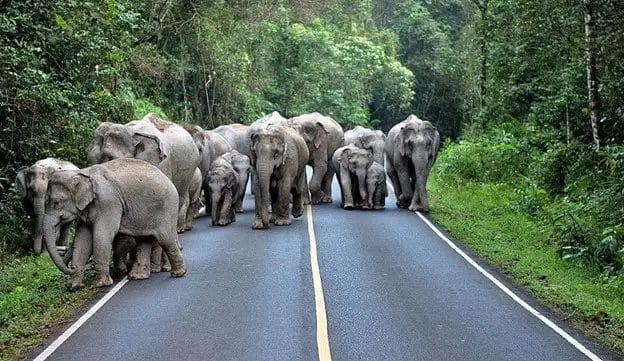
What is Khao Yai National Park?
Khao Yai is one of Southeast Asia’s premier destinations thanks to its diverse wildlife, making it a revered destination for nature enthusiasts visiting Thailand. This remarkable locale has abundant wildlife, including sightings of wild Asiatic elephants, endangered White-handed gibbons, and various species of Hornbills.
Encompassing an expansive area of 2,168 square kilometers, Khao Yai is the third-largest national park in Thailand. It boasts one of Southeast Asia’s largest remaining monsoon forests, which has earned it the prestigious distinction of being a UNESCO site. The majestic Khao Rom (also known as Khao Khieo) Mountain towers 1,351 meters within the park, offering breathtaking vistas. The park’s average elevation ranges from 400 to 1,000 meters above sea level.
It is also part of the Dong Phayayen-Khao Yai Forest Complex, a UNESCO Site spanning five protected areas from Khao Yai to the Cambodian border. Aside from its impressive wildlife, Khao Yai is also home to stunning waterfalls, including the famous Haew Suwat waterfall featured in the movie “The Beach.” During the rainy season, these waterfalls transform into magnificent cascades, surrounded by lush green forests enveloped in mist, creating a truly mesmerizing sight.

Where is Khao Yai National Park?
Established in 1962, Khao Yai is Thailand’s first national park and the third largest. Primarily located in Nakhon Ratchasima Province, it extends into Prachinburi, Saraburi, and Nakhon Nayok provinces. Positioned approximately 180 km from Bangkok, the park’s main checkpoint serves as an entry point for visitors.
Why should you go to Khao Yai National Park?
A UNESCO World Heritage site since 2005, Khao Yai offers a remarkable wildlife experience, particularly for observing mammals, making it one of the most accessible national parks in Thailand. While a few other parks in the country boast impressive wildlife, Khao Yai stands out as an excellent choice for mammal watching. In addition to Kui Buri National Park, Khao Yai provides favorable opportunities to encounter elephants, albeit with a touch of luck.
.
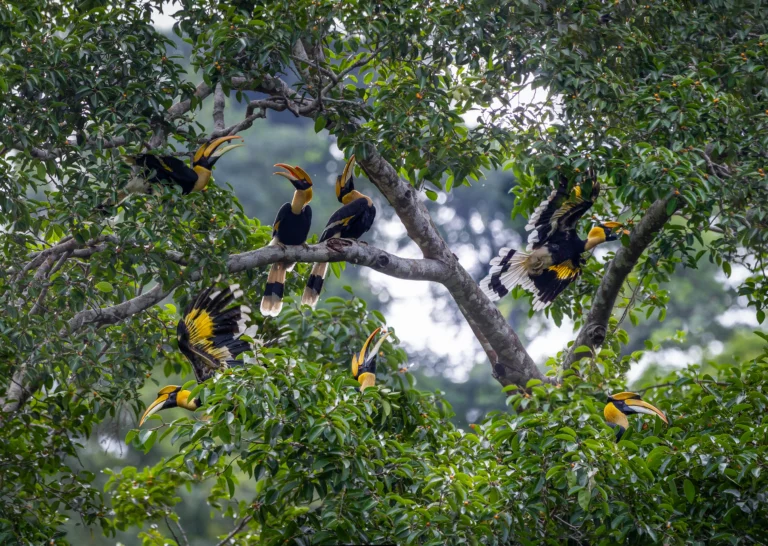
Khao Yai also boasts an impressive record of approximately 440 bird species. Among the avian residents, the park harbors one of Thailand’s largest populations of hornbills. It is common to witness majestic Great Hornbills and Oriental-pied Hornbills gracefully soaring above the visitor center area on a near-daily basis.

The visitor center is the starting point for numerous captivating trails, while some are just a short distance away, a couple of kilometers apart. Most of these trails necessitate the accompaniment of a guide. However, one exception is the 800-meter-long circular trail behind the visitor center, which can be freely explored without a guide.

While the vicinity around the visitor center tends to be bustling, it offers an excellent opportunity to observe various familiar bird species. Kingfishers and hornbills are frequently spotted in this area. Here is why you must add Khao Yai to your Thailand itinerary:

• Breathtaking hiking trails
There are seven designated trails within the national park; for most of them, it is necessary to be accompanied by either a guide or a ranger if one is available. Guides can be arranged through various tour operators or by visiting the park’s official website.
Rangers, on the other hand, should be arranged early in the morning to ensure availability. The trails are officially numbered as follows:

1. Trail #1 | Visitor Center
The shortest and easiest nature trail is perfect for trekkers of all ages, providing a delightful experience. The trail meanders through a combination of pristine rainforest and well-preserved dry forest. As you progress along the path, you’ll come across precious agarwood trees emanating a delightful fragrance.
Keep an eye out for fascinating wildlife sightings and diverse bird species. Finally, at the trail’s conclusion, you’ll be rewarded with the captivating Kong Kaew Waterfall. This picturesque waterfall originates from volcanic rock and is surrounded by a serene freshwater swamp forest, making it visually enchanting and educational.

2. Trail #2 | Pha Kluai Mai Waterfall
This scenic nature trail connects two waterfalls, tracing the path of Lam Ta Khong stream and meandering through alternating sections of bamboo forest and dry forest. As you embark on this journey, you’ll be immersed in the serene atmosphere, accompanied by the resounding roar of Pha Kluai Mai Waterfall during the rainy season.
However, as the water levels recede in the dry season, you’ll have the opportunity to witness the remnants of ancient lava flows from a volcano that existed millions of years ago.
The trail also presents an array of botanical wonders. Among the rocks, you’ll notice the emergence of Polypleurum flowers, a recently discovered species, along with Renanthera orchids, also known as “Whai Daeng,” which contribute to the waterfall’s name due to their white and red blossoms that adorn the surroundings during April.
The water course attracts a diverse range of animal species. Butterflies flutter gracefully, water dragons and otters frolic in the vicinity, while groups of gibbons swing through the treetops.
Towards the trail’s end, you’ll encounter rock platforms within the stream, only visible during the dry season, adding an intriguing touch to the natural spectacle.
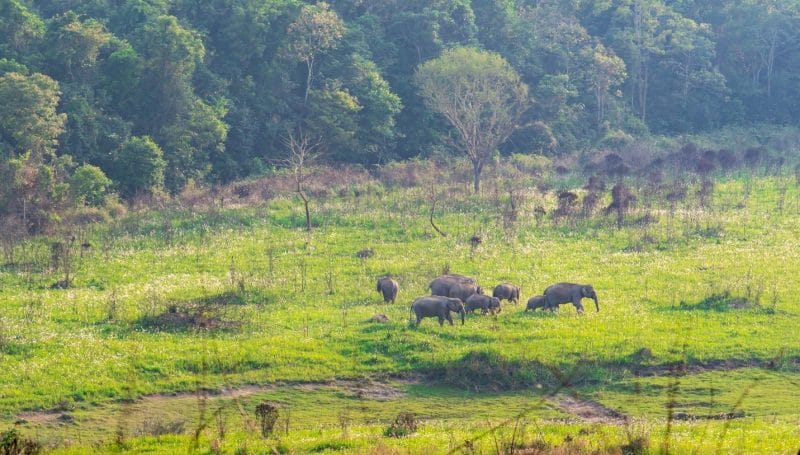
3. Trail #3 | Km 33 - Nong Pak Chi Tower
This nature trail showcases diverse forest types, including mature dry forest, secondary forest, and grassland. The entire trail is shaded by towering trees like banyan and java plum, which bear delicious fruits attracting various birds and animals, effectively creating a natural “wildlife restaurant.”
One notable feature along the trail is the presence of giant trees, which are exclusive to the Dong Phaya Yen complex.
Additionally, this trail serves as a foraging path for elephants and gaur, so you might encounter their tracks or dung along the way. Upon reaching the Nong Phak Chi Observation Tower, you can observe many animals near water sources and salt licks in the grass.

4. Trail #4 | Dong Tiew - Sai Sorn Reservoir
Embark on a beautiful one-way trail that guides you to Sai Sorn Reservoir, an enchanting location to witness the mesmerizing sunset. As you traverse the trail, you’ll pass through dry and secondary forests, which serve as the natural habitat for the magnificent Lar gibbon.
During the rainy season, the landscape transforms into a splendid tapestry of vibrant flowers, including the elegant balloon plant, begonia, and mossiata.
A true highlight along the trail is a century old giant Biang tree, standing tall as a testament to time. The secondary forest boasts a relatively open terrain, offering ample opportunities to spot a plethora of bird species, such as the captivating blue-eared barbet, the melodious stripe-throated bulbul, the distinctive, black-crested bulbul, and the graceful green-billed malkoha.
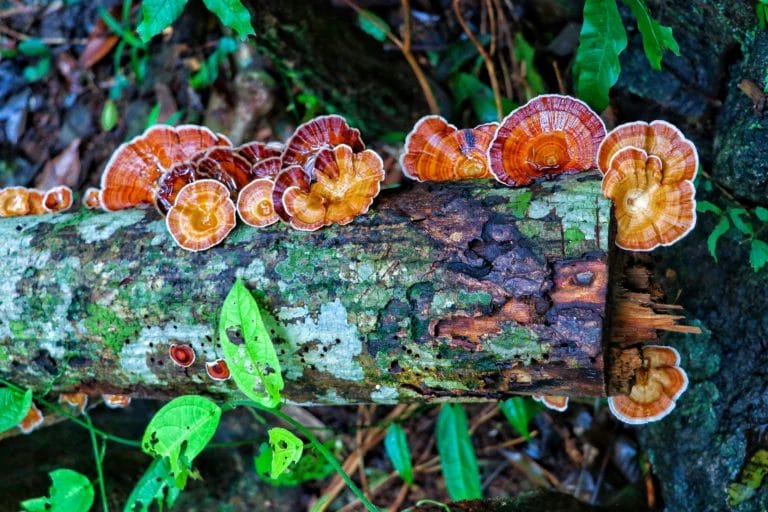
5. Trail #5 | Dong Tiew - Nong Pak Chi Tower
Trail No. 4 and this trail share the same starting point. It is a nature study trail, offering a captivating journey through various forest types. The trail alternates between level basins and steep paths that traverse hills. One of the main attractions along this trail is a majestic Biang tree, standing tall for centuries.
During the rainy season, you might come across wild mushrooms displaying peculiar shapes and vibrant colors. This trail also serves as a foraging ground for numerous animals. You’ll reach the Nong Phak Chi Observation Tower as you approach the trail’s end.
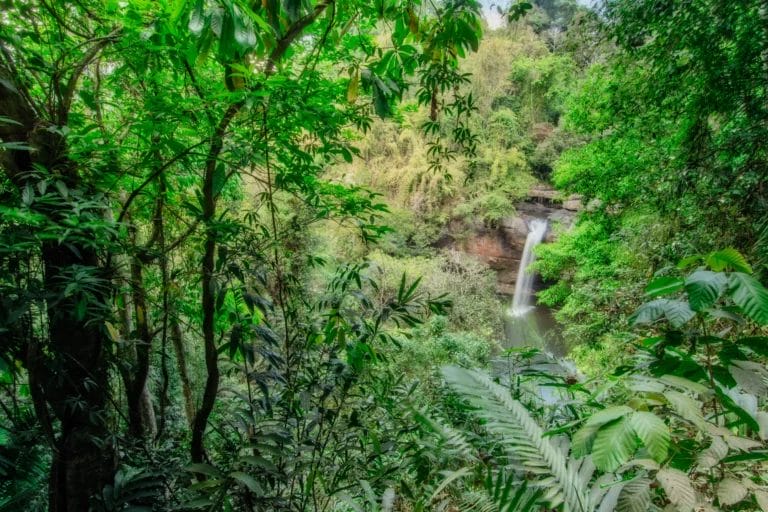
6. Trail #6 | Visitor Center - Haew Suwat Waterfall
Embarking on this nature trail is an immersive and educational experience, spanning a considerable distance. Along the way, you’ll traverse a diverse landscape alternating between lush rainforests and dry forests, with intermittent stretches of enchanting bamboo groves.
The trail showcases an array of fascinating plant species, including the majestic Siamese rosewood and the fragrant agarwood.
Additionally, you’ll encounter dense thickets of towering ferns. With its numerous twists and turns, this trail presents a challenge for adventurers.
Furthermore, it serves as a foraging path for wild elephants, making navigation somewhat perplexing. Therefore, having an experienced trail guide accompany you is highly recommended, ensuring a safe and enriching journey.

7. Trail #7 | Thai - American Friendship Trail
The newest trail in Khao Yai National Park commemorates the enduring and amicable bond between Thailand and the USA. Alongside notable landmarks highlighting this historical relationship, the trail adheres to the high standards set by the United States national parks through the Sister Parks Arrangement for Resources and Knowledge Sharing (SPARK).
As you explore the trail, you will traverse various ecological zones, including dry forests, secondary forests, and grasslands. Also, you can watch fascinating wildlife encounters like the Siamese Fireback, silver pheasant, gibbons, and hornbills.
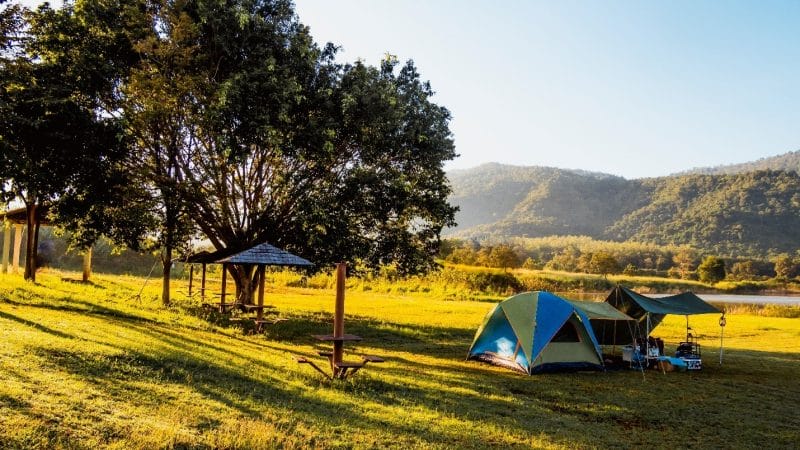
• Beautiful Campsites
Within the park boundaries, two well-equipped campsites (Lam Ta Khong Campsite and Pha Kluai Mai Campsite) offer amenities such as toilets, showers, and parking spaces.
If you don’t have a tent, you can rent one for 250 baht (about 7 USD), suitable for two people. Additionally, accessories like sleeping bags, pillows, and blankets can be rented individually for 20-50 baht (~0.50-1.50 USD) each. Both campsites are surrounded by picturesque areas that are perfect for hiking.
Nighttime temperatures can drop as low as 9-10 °C (48-50°F) in winter. It is advisable to bring warm clothes for a comfortable sleep, activities like going to the toilet during the night, and early morning or late evening hikes.

• Nong Phak Chi Wildlife Observation Watchtower
This watchtower is 2.5 km northwest of the visitor center and offers an excellent vantage point to admire the beautiful surrounding grasslands. Adjacent to the tower, you’ll find a salt lick and a pond that often attracts various animals.
Elephants occasionally make appearances in this area as well. Moreover, the vicinity of the watchtower boasts a network of trails, perfect for exploring the surroundings.

• Haew Narok Waterfall
The largest waterfall in the park, boasting a height of 80 meters for its highest tier, has a cumulative altitude of 150 meters. This three-tiered waterfall is approximately 10 km north of the southern gate and offers magnificent views.
To access it, follow a 600-meter trail from a car park adjacent to the main road. Restrooms and a restaurant are available near the car park.
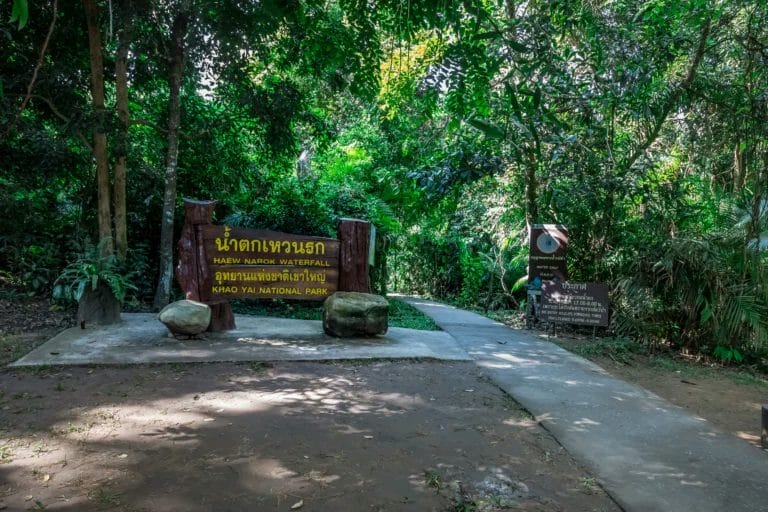
Located before descending to the viewpoint, there is a pavilion-like resting area where a trail of about 600-800 meters commences. This trail leads to a superior vantage point that provides a breathtaking view of the waterfall from a higher elevation, ideal for capturing stunning landscape photography.
Additionally, the short trail leading to the waterfall is an excellent spot to observe various bird species, lizards, macaques, and potentially even elephants.

• Haew Suwat Waterfall
Located approximately 13 km from the visitor center, Haew Suwat Waterfall stands tall at 20 meters. This enchanting waterfall has been the backdrop for numerous film scenes, with Leonardo Di Caprio’s iconic jump scene from “The Beach” the most renowned.
Accessible with ease, the waterfall is just a mere hundred meters away from the car park, making it convenient to reach by scooter or car. Adjacent to the car park, the restaurant remains open regularly, providing a convenient dining option.
Moreover, hidden within the open space near the restaurant, there is an alternative trail leading to the top of the waterfall, where the famous jump scene was filmed. This hidden path is less than a 200-meter walk away.
.
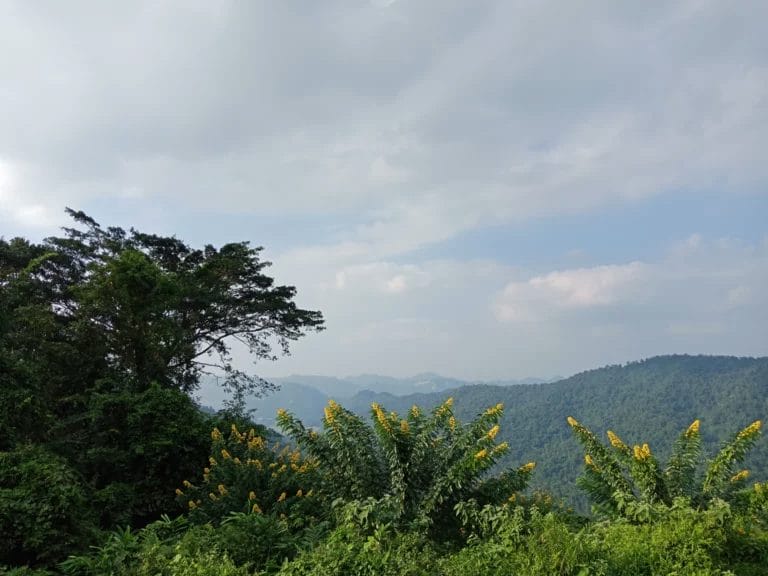
• Yod Khao Khieo Mountain
At an impressive 1,292 meters above sea level, the mountain is the highest point in Nakhon Nayok Province. It is about 11 km from the visitor center, accessible by car or motorbike to the summit.
Along this route, you will encounter three stunning viewpoints and several short trails offering picturesque vistas of the surroundings.
Please note that this road and the viewpoints are closed to visitors annually from June 1st. until September 30th. This temporary closure aims to provide an undisturbed environment for the forest to regenerate.
Additionally, during the rainy seasons, occasional road closures may occur due to landslides blocking the way to the viewpoints. These closures are implemented for safety reasons.

• Khao Luk Chang Bat Cave
It is believed that one to three million wrinkled-lipped bats inhabit this cave. At sunset, a mesmerizing sight unfolds as a vast swarm of bats emerges from the cave, creating a breathtaking spectacle that lasts for hours.
It is not uncommon to witness certain birds of prey swooping down to feed on the bats within this cloud of flying creatures. The cave lies approximately 4.5 km from the north gate of the national park. Using a sturdy terrain vehicle for visiting the cave is advisable, as the road conditions might be challenging.
When is the best time to visit Khao Yai National Park?
The ideal time to visit Khao Yai varies depending on your preferred activities.
For wildlife enthusiasts and those who appreciate stunning waterfalls, the period between June and October, which coincides with the rainy season, is highly recommended.
Despite sounding unconventional, this is when the forests flourish, the waterfalls reach their peak flow, and the elephants display increased activity.
If hiking is your primary interest, the cool season from November to February offers the most favorable weather conditions. During this time, temperatures are at their coolest, and you can still encounter remarkable wildlife while the jungle retains its vitality.
From the end of February until the conclusion of April, Thailand experiences its hottest period. The forests and jungles begin to dry up, and the waterfalls recede. However, this time is particularly advantageous for birdwatchers seeking avian sightings.
Ultimately, your choice should be based on what you desire to observe within the park.
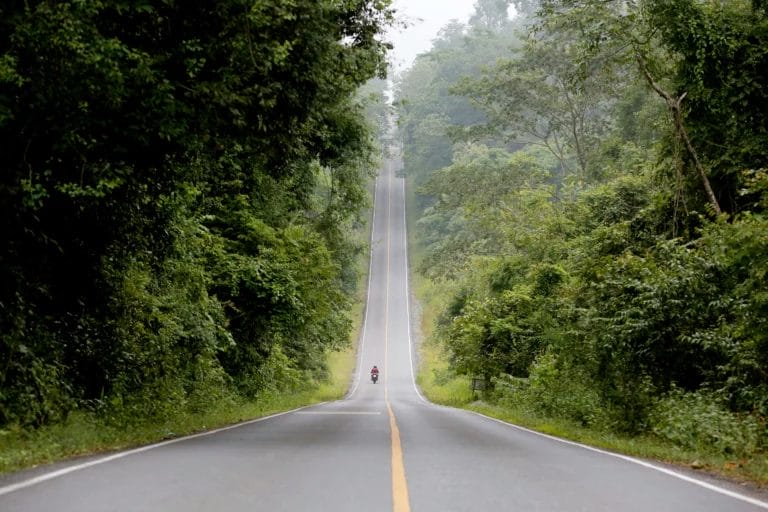
How to get to Khao Yai National Park?
Khao Yai National Park is situated approximately 200km northeast of Bangkok. If you plan to visit the park, here are a few transportation options;
• By Bus/ Private Minivan
Route 1
You have two transportation options to reach Pak Chong: the Bangkok-Nakhon Ratchasima coach or a private minivan from Bangkok to Pak Chong.
Once you arrive at Pak Chong, you can choose between hiring a taxi and taking the Pak Chong-Khao Yai bus.
The bus operates from 6:00 AM to 5.00 PM daily, departing every 30 minutes. The bus fare is 15 baht (~ 0.50 USD), and it will take you to the Chao Por Khao Yai Shrine Visitor Center, which serves as the entrance gate to the National Park.
From there, you can explore the various attractions of Khao Yai National Park. If needed, you can also rely on other visitors’ vehicles for further travel within the park.
Route 2
Board the Bangkok-Prachinburi coach and disembark at the Naresuan Shrine Roundabout, which serves as the junction for Prachinburi.
Once there, you can opt for a motorcycle taxi or any other vehicle available to visitors to reach the Noen Hom Visitor Center and explore the various tourist attractions within Khao Yai National Park.
• By Train
Another option is to take a train from Bangkok. The train journey lasts 3 hours and costs at least 140 baht (~ 4 USD). However, ticket prices can go up to 900 baht (~ 25 USD).
Board the under Northeastern line (Bangkok-Pak Chong) and disembark at Pak Chong station in Nakhon Ratchasima province. You will then take a Songthaew bus from Pak Chong Market to Khao Yai National Park.
• By Taxi
For a more private and direct transfer, you can arrange a taxi from any hotel or airport in Bangkok to a hotel located north of Khao Yai. The cost starts from around 2,200 baht (~60 USD). The journey usually takes about 2 hours and 30 minutes in favorable traffic conditions.







8 Responses
Hey Benjamas, Chrysanthemum flower; nice name by the way.
Your article about Khao Yai National Park is incredibly informative and inspiring! Reading about the diverse wildlife, stunning waterfalls, and beautiful landscapes has truly piqued my interest.
I can’t wait to visit and explore the trails, observe the wildlife, and experience the natural beauty firsthand. Thank you for providing such detailed insights into this amazing destination!
Hi earlofpearl,
Thank you so much for your kind words and for taking the time to read my article on Khao Yai National Park! I’m happy to hear that you found it informative and inspiring.
Khao Yai truly is a gem with its diverse wildlife and breathtaking landscapes. I’m sure you’ll have an incredible time exploring the trails, observing the wildlife, and experiencing the beauty of nature!
If you have any questions or need any further tips as you plan your visit, feel free to reach out. I hope you have an amazing adventure in Khao Yai National Park! And thank you again. (:
Benjamas
Khao Yai National Park looks absolutely amazing! I love these parks and how they promote the well-being of the animals within. Your information on various trails and the various animals that can be seen by visitors is enlightening. Your photographs are stunning – definitely this is somewhere I would now consider visiting! And there is a bat cave!! Fantastic. Thank you for sharing this 🙂
Thank you so much for your kind words! I’m glad to hear that you enjoyed reading about Khao Yai National Park and found the information helpful. It truly is a remarkable destination, filled with diverse trails and incredible wildlife encounters.
I’m glad my photographs could inspire you to consider visiting! And yes, the bat cave is definitely a highlight – a truly unique experience. If you decide to visit, I’m sure you’ll have an amazing time exploring all that the park has to offer. Thank you again for your support! (:
Khao Yai National Park sounds like an absolute paradise for nature enthusiasts! The abundance of wildlife, stunning waterfalls, and diverse landscapes make it a must-visit destination for anyone looking to immerse themselves in the beauty of nature.
I’m particularly drawn to the idea of exploring the various hiking trails within the park, especially Trail #1 leading to Kong Kaew Waterfall. The opportunity to encounter precious agarwood trees emitting a delightful fragrance along the way sounds like a sensory delight.
Additionally, the chance to witness the breathtaking sunset at Sai Sorn Reservoir and the iconic Haew Suwat Waterfall, featured in “The Beach,” adds to the allure of visiting Khao Yai.
Considering the convenience of transportation options from Bangkok, including buses, trains, and taxis, it seems like planning a trip to Khao Yai National Park would be relatively straightforward.
Overall, after reading about the park’s remarkable attractions and accessibility, I’m seriously considering adding it to my travel bucket list. It seems like an ideal destination to reconnect with nature and create unforgettable memories amidst Thailand’s natural splendor.
Hi Ashley,
Thank you for reading my articles! I’m glad to hear that you’re considering adding Khao Yai to your travel bucket list! It’s truly an ideal destination to reconnect with nature.
Khao Yai provides abundant chances for unforgettable experiences, whether hiking in lush forests, admiring stunning waterfalls, or enjoying the peacefulness of nature.
If you decide to visit, I’m sure you’ll have an amazing time exploring all that Khao Yai National Park!
Thank you again!
Benjamas
Your detailed and informative article showcases Khao Yai National Park as a must-visit destination for nature enthusiasts, thanks to its rich biodiversity and stunning landscapes. The tips and recommendations for visitors are particularly helpful. I’m curious, have you had any memorable encounters with unique wildlife or experiences while exploring the park? If so, what was your favorite?
Hi Kiersti,
Thank you for your kind words about the article! I’m glad you found it informative and helpful. Exploring Khao Yai National Park was indeed an unforgettable experience, filled with remarkable encounters with unique wildlife. There’re lots of elephants and colorful birds. One of my most memorable experiences was encountering a family of gibbons swinging through the trees. Witnessing these incredible creatures in their natural habitat was a great experience!
Thank you again!